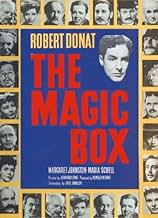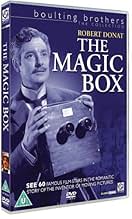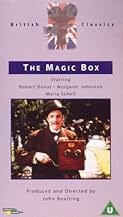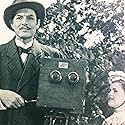VALUTAZIONE IMDb
7,0/10
1449
LA TUA VALUTAZIONE
Aggiungi una trama nella tua linguaA chronicle of the life of William Friese-Greene, a British inventor and early pioneer in cinema.A chronicle of the life of William Friese-Greene, a British inventor and early pioneer in cinema.A chronicle of the life of William Friese-Greene, a British inventor and early pioneer in cinema.
- Nominato ai 2 BAFTA Award
- 1 vittoria e 2 candidature totali
Renée Asherson
- Miss Tagg
- (as Renee Asherson)
Trama
Lo sapevi?
- QuizOne of the extras in this movie is a teenage Ronald Kray (later the infamous London gangster).
- BlooperIn 1915 when Green's three eldest sons join the army, the landlord's agent mentions that the Spanish influenza is going around. In actuality the Spanish influenza did not begin until 1918.
- Citazioni
William Fox-Talbot: The original thinker - the innovator - mustn't mind seeming a little foolish to his contemporaries. He must always look to his star... In the end, he may still fail. That's unimportant. If he is true to himself, he won't be too unhappy or embittered, even in failure, and will still speak for what is good.
- Curiosità sui creditiClosing credits superimposed over the tablet bearing the following: WILLIAM FRIESE-GREENE 1855 - 1921 A PIONEER OF THE CINEMA
- ConnessioniEdited into Kraft Television Theatre: The Magic Box (1956)
Recensione in evidenza
This is the 1951 feature made by the British film industry to celebrate the festival of Britain. The film stars a virtual who's who of all the famous British cinema actors of that time, and one of the fun things about this film is trying to identify all of them as they pop up in various cameo roles. The story is the biography of William Friese- Greene, who this film claims invented the motion picture camera and projector. Edison and Lumiere are casually acknowledged as also being motion picture pioneers, but Friese-Greene is claimed to have had the first intermittent mechanism (presumably the Maltese cross) used in today's cinema projectors. It also claims that he invented the biocolour process, where color motion pictures are produced by rotating two color filters in front of the camera and projector (KinemaColour). The lead role is beautifully played by Robert Donat as the quiet intense inventor obsessed with producing moving photographs, and his wife is competently played by Maria Schell. Also appearing in cameo roles are Michael Redgrave, Richard Attenborough, Peter Ustinov, Stanley Holloway, Michael Dennison, the great Dennis Price, the beautiful Glynnis Johns and her father Mervyn Johns, the eccentric Joyce Grenfell, the wonderful Margeret Rutherford, and a host of others too long to mention. The most famous cameo is by Sir Laurence Olivier, as the astonished policeman who witnesses Friese-Greene's first triumph, the projection of moving images of Hyde Park on an improvised sheet screen. This is the most remembered scene of the film, and Friese Greene's excitement at this event reminded me of my own excitement when I first turned the handle on my first Pathescope 9.5mm projector! The film is of great interest to film collectors and movie buffs, containing beautiful shots of old wood and brass magic lanterns and early movie equipment. There are many wonderful scenes, such as the Victorian photo studio where they show customers having to stand absolutely still for 30 seconds to get their photo taken! The film was produced by Roy Boulting, and the beautiful Victorian settings and costumes are sumptuously photographed by Jack Cardiff. My family and friends really enjoyed this movie, it is low key almost like a BBC period drama, but if you are a film collector you will love it. We take the showing of films in our homes for granted these days, and it easy to forget the real struggle by inventors such as Friese- Greene to achieve what seemed impossible at the time. American audiences will of course have to (at least temporarily) suspend their belief that Edison was the sole inventor of the motion picture camera ( in fact Edison was primarily a business man and entrepreneur who copied many of the motion picture concepts developed by Lumiere in France) This film is very rare indeed. I don't think it exists on VHS or DVD,(certainly not in the USA), however Super 8mm film prints do exist, so if you find an S8 print grab it! My particular super 8 print is a 2400 ft Agfa color print, pin sharp with beautiful rich colors and great contrast. The mono magnetic track sound quality is very good for a film of 1951 vintage. Highly recommended, if you can find it.
I più visti
Accedi per valutare e creare un elenco di titoli salvati per ottenere consigli personalizzati
- How long is The Magic Box?Powered by Alexa
Dettagli
- Tempo di esecuzione1 ora 58 minuti
- Proporzioni
- 1.37 : 1
Contribuisci a questa pagina
Suggerisci una modifica o aggiungi i contenuti mancanti

Divario superiore
By what name was Stupenda conquista (1951) officially released in Canada in English?
Rispondi





















